So, you’re ready to embrace the incredible full-body workout a rowing machine offers, but you’ve hit your first fork in the road: which type of rower is right for you?
It can feel a bit like choosing a new car – each model has its unique engine, feel, and features.
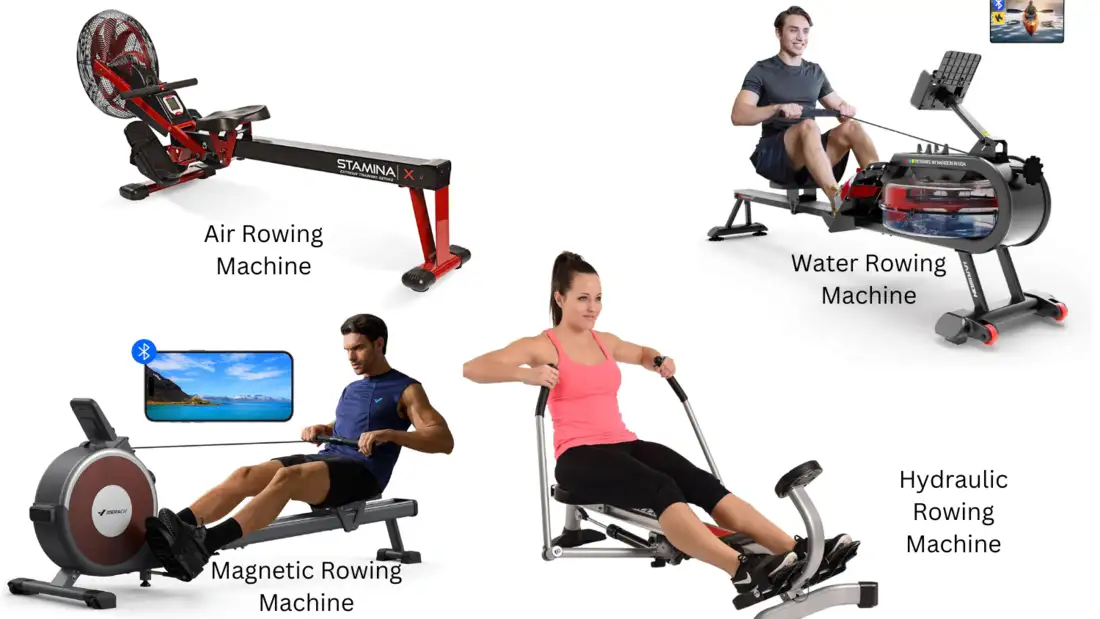
Understanding the fundamental differences between air, magnetic, water, and hydraulic rowers is crucial to picking a machine that aligns with your fitness goals, home environment, and budget.
This comprehensive guide is designed to demystify the world of rowing machine types.
We’ll break down how each one works, explore its unique pros and cons, and help you pinpoint the ideal match for your beginner journey.
If you’re looking for the broader picture on why rowing is so beneficial, be sure to check out our page on The Full-Body Benefits of Rowing for Beginners.
But for now, let’s get mechanical!
The Core Difference – How Resistance is Created
At the heart of every rowing machine is its resistance system.
This is what provides the challenge your muscles work against, and it’s the primary factor distinguishing one type of rower from another.
The way resistance is generated profoundly impacts:
- The “Feel” of the Stroke: Does it feel smooth, consistent, or dynamically responsive like rowing on water?
- Noise Level: Crucial if you live in an apartment or have housemates who appreciate quiet.
- Maintenance Requirements: Some types are virtually maintenance-free, while others need a little TLC.
- Footprint & Storage: Design often varies with the resistance mechanism.
- Price: Different technologies come with different price tags.
Let’s dive into the specifics of the four main players in the rowing machine arena.
1. Air Resistance Rowers – The Athlete’s Choice
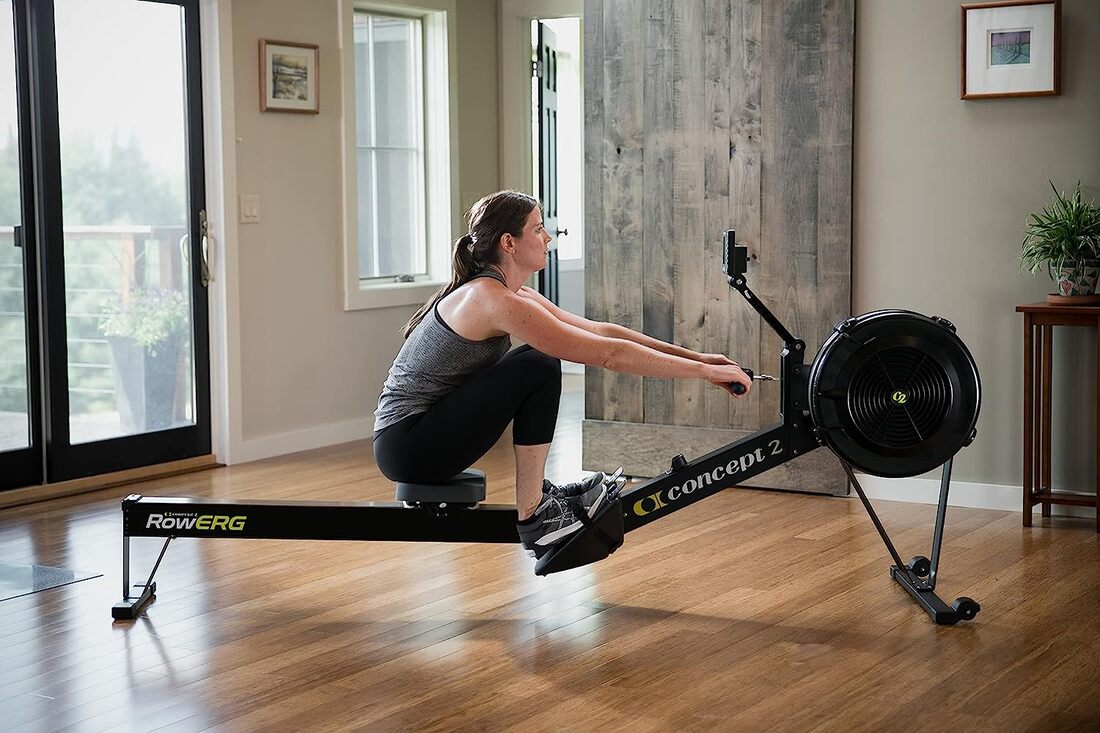
Often seen in commercial gyms and a favorite among competitive rowers, air resistance rowers utilize a fan flywheel to generate resistance.
How Air Rowers Work
As you pull the handle, you spin a flywheel with attached fan blades. These blades push against the air, creating resistance.
The physics are simple yet effective: the harder and faster you pull, the more air the fan moves, and the greater the resistance you encounter.
It’s a dynamic relationship – the machine responds directly to your effort.
Most air rowers also feature a damper setting, which isn’t a direct resistance control but rather adjusts how much air enters the flywheel housing, affecting the feel of the stroke (akin to the gearing on a bike or the drag of a boat in water).
Concept2 provides an excellent explanation of damper settings.
Pros of Air Rowers
- Responsive & Unlimited Resistance: The resistance naturally scales with your intensity. The harder you work, the harder it gets.
- Smooth Stroke Cycle: High-quality air rowers offer a very smooth and consistent feel throughout the pull.
- Accurate Performance Monitoring: Often paired with advanced monitors that provide precise data, making them great for tracking progress and for athletes.
- Durable & Low Maintenance: Generally robustly built and require minimal upkeep beyond occasional cleaning.
- Excellent for HIIT: The responsive nature is ideal for high-intensity interval training.
Cons of Air Rowers
- Noise: The spinning fan creates a “whooshing” sound that can be quite loud, potentially an issue in shared living spaces.
- Larger Footprint: Tend to be longer to accommodate the flywheel and slide rail.
- Can Feel “Heavy” if Damper is High: Beginners might find higher damper settings challenging if not accustomed to it.
Who Are Air Rowers Best For?
- Individuals seeking a gym-quality, performance-oriented workout.
- Those who appreciate responsive resistance that matches their effort.
- Anyone who isn’t overly concerned about noise levels.
- Beginners who are serious about long-term rowing and potential performance tracking.
2. Magnetic Resistance Rowers – The Silent Performer
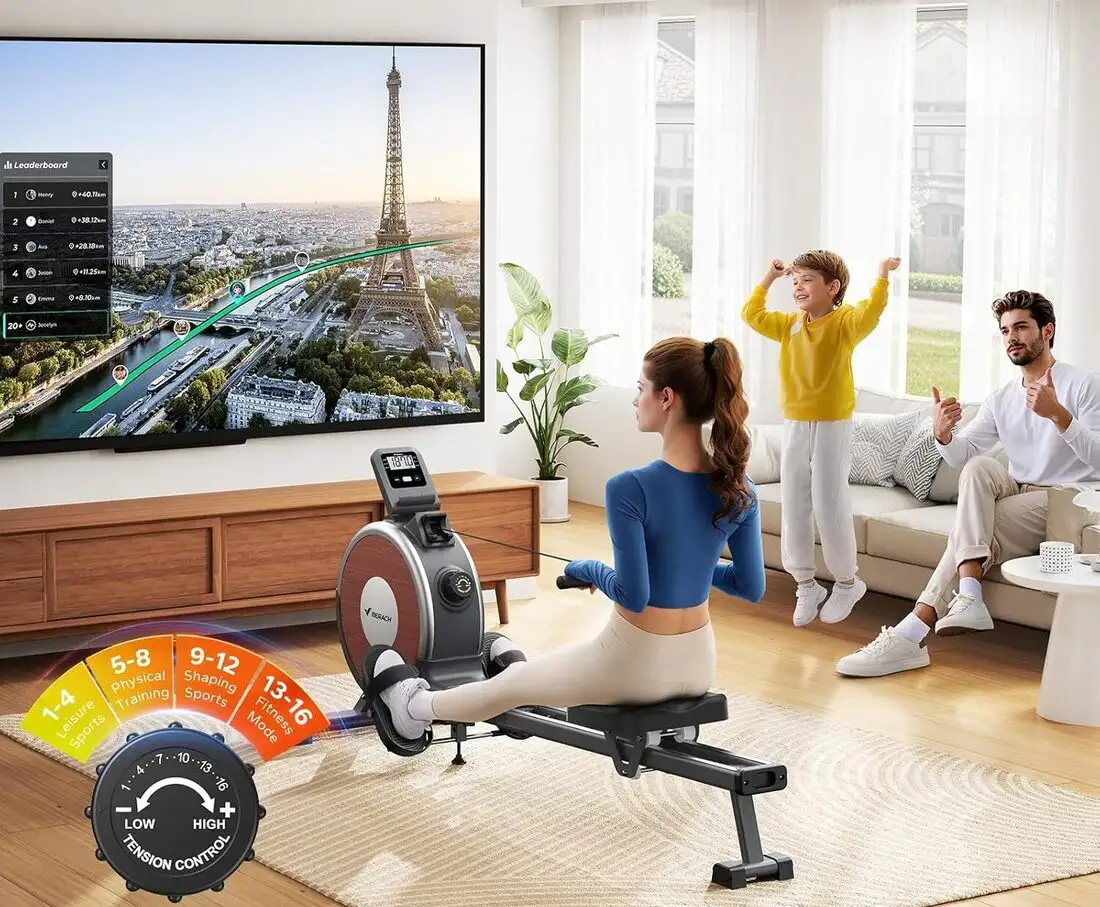
Magnetic rowers are a popular choice for home users, primarily due to their exceptionally quiet operation.
How Magnetic Rowers Work
These machines use magnets and a metal flywheel.
As you row, the flywheel spins. The resistance is created by moving the magnets closer to or further away from this flywheel.
The closer the magnets, the stronger the magnetic force, and the greater the resistance.
This adjustment is typically done either manually via a dial or electronically through the console, offering predefined resistance levels.
Pros of Magnetic Rowers
- Virtually Silent Operation: Their biggest selling point. Perfect for apartments, early morning workouts, or when others are nearby.
- Smooth & Consistent Resistance: The magnetic system provides a very fluid and predictable pull.
- Defined Resistance Levels: Makes it easy to select a specific intensity and track progress across consistent levels.
- Often More Compact: Some models can be more space-efficient than air rowers.
- Low Maintenance: Minimal moving parts in the resistance system mean little upkeep.
Cons of Magnetic Rowers
- Less “Dynamic” Feel: The resistance is set and doesn’t change based on how hard you pull within that level, which some users find less engaging than air or water.
- Potentially Limited Top-End Resistance: While perfectly adequate for most beginners and intermediate users, elite athletes might find the maximum resistance on some models insufficient.
- Resistance Steps Can Be Broad: On some budget models, the jump between resistance levels might feel too large.
Who Are Magnetic Rowers Best For?
- Home users who prioritize quietness above all else.
- Beginners who appreciate easily selectable and consistent resistance levels.
- Those living in apartments or shared spaces.
- Individuals looking for a smooth, low-maintenance rowing experience.
3. Water Resistance Rowers – The Natural Feel
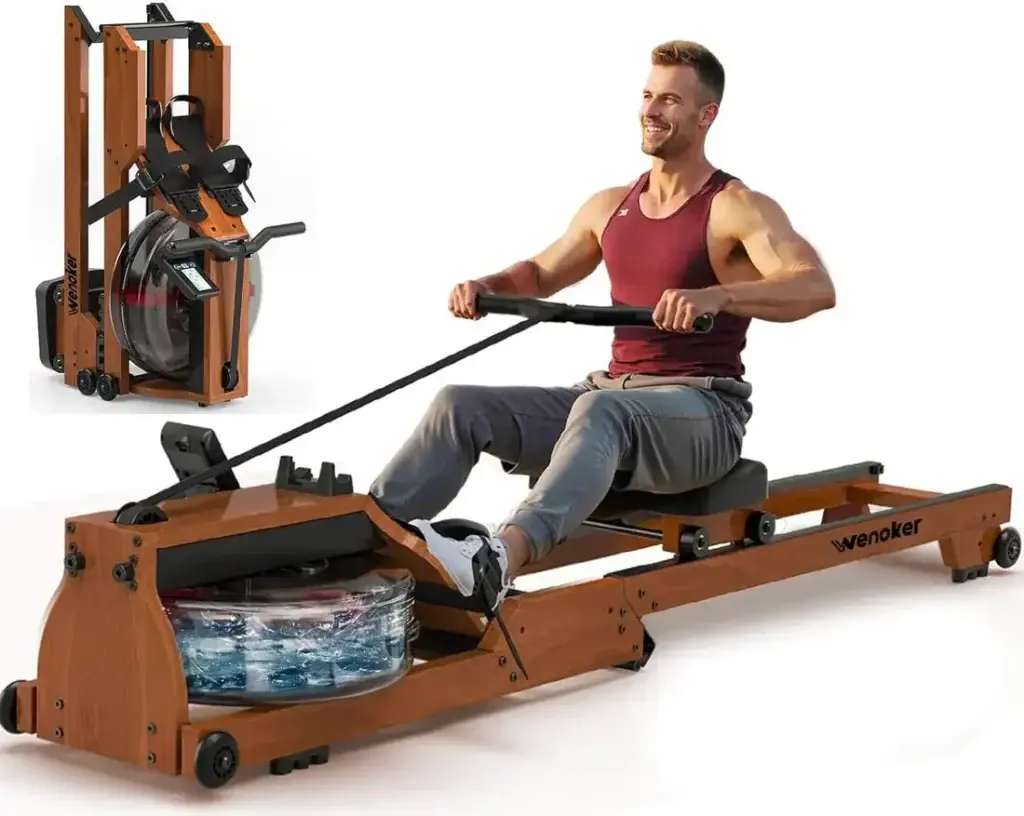
Water rowers aim to replicate the authentic experience of rowing on actual water, both in feel and sound.
How Water Rowers Work
These rowers feature paddles or blades suspended inside a sealed tank filled with water.
When you pull the handle, these paddles spin through the water, creating resistance.
Similar to air rowers, the resistance is dynamic: the harder and faster you pull, the more resistance the water provides.
The level of resistance can also be subtly adjusted by changing the amount of water in the tank.
Pros of Water Rowers
- Most Realistic On-Water Feel: Many users find the smooth, consistent resistance throughout the stroke closely mimics actual rowing.
- Soothing “Swoosh” Sound: The sound of water moving can be quite meditative and pleasant, far less intrusive than air rowers for some.
- Dynamic Resistance: Responds to your effort level, becoming more challenging as you pull harder.
- Aesthetically Pleasing: Often beautifully crafted, with many models made from wood, making them an attractive piece of furniture.
- Engaging Workout: The combination of feel and sound can make workouts more enjoyable.
Cons of Water Rowers
- Price: Generally among the more expensive types of rowing machines.
- Size & Weight: Can be larger and heavier (especially when the tank is full of water), making them harder to move.
- Maintenance: Requires occasional water treatment (e.g., purification tablets) to keep the water clean and prevent algae growth. The tank may need emptying if the rower is to be moved significantly or stored for long periods.
- Potential for Leaks (Rare): Though uncommon with quality models, a tank of water always carries a very small risk.
Who Are Water Rowers Best For?
- Individuals who want the closest experience to on-water rowing.
- Those who appreciate the aesthetic appeal and the soothing sound of water.
- Users looking for dynamic resistance in a more tranquil package than air rowers.
- Beginners with a moderate to higher budget who value the sensory experience.
4. Hydraulic Piston Rowers – The Compact & Budget-Friendly Option
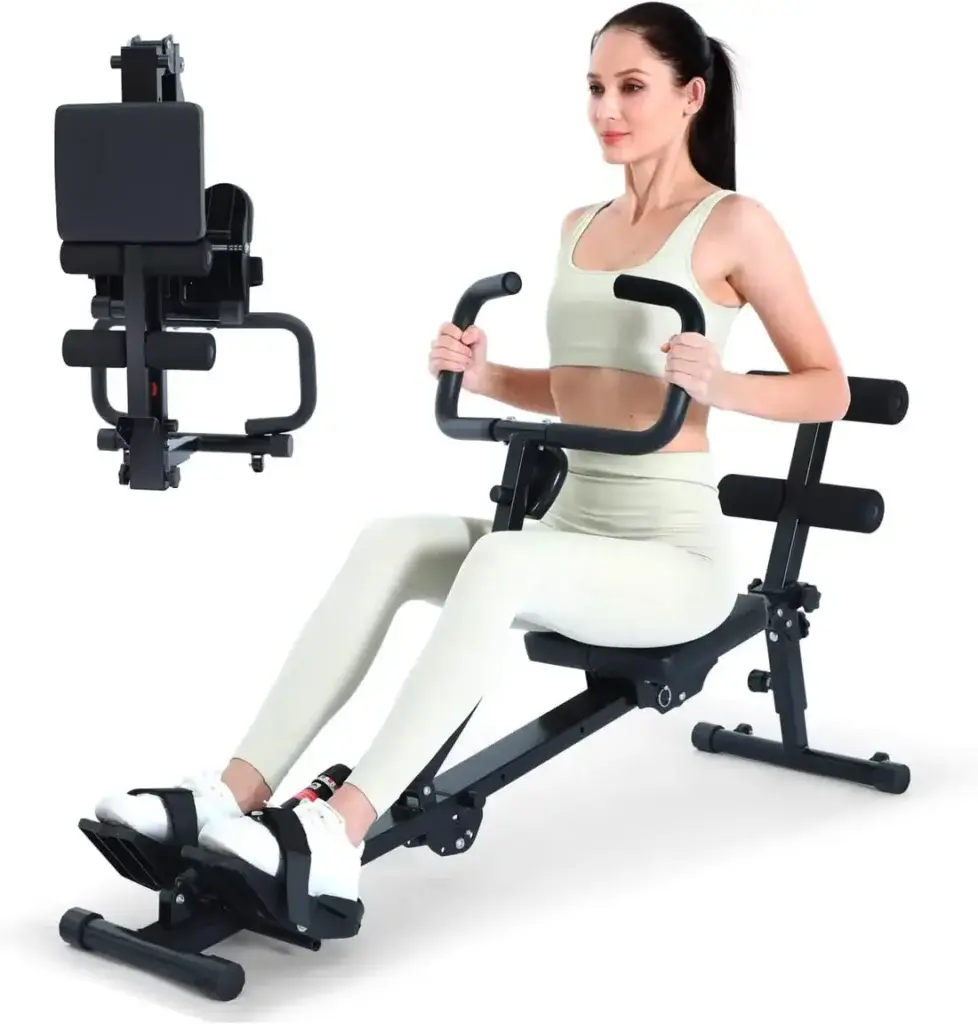
Hydraulic rowers are typically the most basic and affordable type, often appealing to beginners on a tight budget or with very limited space.
How Hydraulic Rowers Work
These machines use hydraulic cylinders (pistons) attached to the rower’s arms or handles.
When you pull, you move the piston, and the hydraulic fluid within creates resistance.
Resistance levels are usually adjusted via a dial or clamp on the pistons themselves.
Many hydraulic rowers have independent arms, mimicking an oar-like motion rather than a single central handle.
Pros of Hydraulic Rowers
- Most Affordable: Generally the lowest-priced rowing machines on the market.
- Very Compact & Lightweight: Ideal for small apartments or those with minimal storage space. Many can be easily tucked away.
- Quiet Operation (Initially): Can be very quiet, though some mechanical noises can develop over time.
Cons of Hydraulic Rowers
- Less Natural Rowing Motion: The stroke often doesn’t feel as smooth or fluid as other types. Models with fixed arms can restrict natural movement.
- Limited Range of Motion: The stroke length can sometimes be shorter.
- Resistance Can Be Inconsistent: Pistons can heat up with prolonged use, potentially affecting resistance levels and smoothness.
- Durability Concerns: Often made with less robust materials, so may not be as long-lasting as more expensive types, especially with heavy use.
- Less Sophisticated Monitors: Consoles are typically very basic, offering limited data.
Who Are Hydraulic Rowers Best For?
- Absolute beginners on a very strict budget.
- Individuals with extremely limited workout space.
- Those who want to try rowing without a significant financial commitment, understanding it may not offer the premium experience of other types.
Quick Comparison – Which Rower Type Suits You?
To help you visualize, here’s a quick reference table:
Rowing Machine Type Comparison Table
| Feature | Air Resistance | Magnetic Resistance | Water Resistance | Hydraulic Piston |
| Primary Pro | Responsive, high performance | Ultra-quiet, smooth | Realistic feel, soothing sound | Most affordable, compact |
| Primary Con | Noisy | Less dynamic feel | Pricier, water maintenance | Less natural motion, durability |
| Feel | Dynamic, matches effort | Consistent, set levels | Dynamic, mimics water | Can be less fluid |
| Noise Level | Loud | Very Quiet | Moderate (Swoosh) | Quiet to Moderate |
| Maintenance | Low (clean fan) | Very Low | Water treatment | Piston wear, potential leaks |
| Price Range | Mid to High | Low to Mid | Mid to High | Low |
| Best For | Serious training, HIIT | Quiet home use, apartments | Realistic feel, aesthetics | Tight budgets, small spaces |
Making Your Choice – Key Considerations for Beginners
Choosing the best rowing machine type for a beginner isn’t just about features; it’s about what fits your life. Consider:
- Your Budget: Be realistic about what you can spend. While pricier models offer more, even a good budget rower can provide an effective workout.
- Available Space: Measure your workout area. Do you need something that folds or stores upright easily? This is where understanding [key rower features like storage (internal link to features child page)] becomes important.
- Noise Tolerance: If you live with others or in an apartment, a magnetic or water rower might be preferable to a louder air rower.
- Fitness Goals: Are you aiming for casual fitness, serious performance tracking, or the most immersive experience?
- Desired “Feel”: If possible, try different types at a local gym or store. What feels most comfortable and motivating to you?
Conclusion – Your Perfect Rowing Partner Awaits
Understanding the nuances of air, magnetic, water, and hydraulic rowing machine types empowers you to make an informed decision and invest wisely in your home fitness journey.
Each type has its champions and its trade-offs, but the “best” one is ultimately the one that you’ll use consistently and enjoy.
Remember, the machine itself is a tool; your commitment and proper rowing technique are what will truly unlock those incredible fitness benefits.
What are your thoughts?
- Which rowing machine type are you leaning towards and why?
- Do you have experience with any of these types that you’d like to share?
Drop a comment below – we’d love to hear from you and help answer any further questions!
Ready to explore more?
- Return to our Beginners Guide to Rowing Machines for a complete overview.
- Learn about Key Rower Features to Look For beyond just the resistance type.
- Once you’ve chosen, check out some Simple Rowing Workouts for Beginners!
